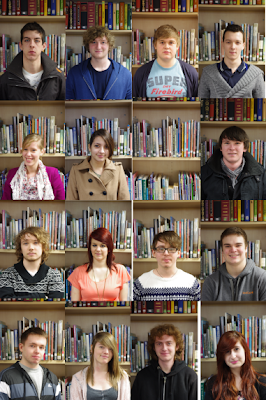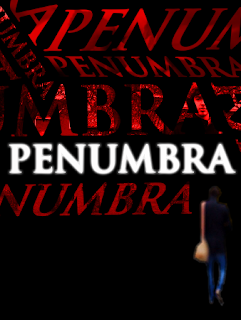A while ago, I created a potential layout for our subsidiary task of a magazine review page, but since then, using the results of our audience research and having analysed some professional film reviews, Tom has developed a much better looking layout.
The full details of the review-page construction are here in Tom's post.
Just as I took the lead in the creation of our poster, with Tom contributing to the design, Tom is constructing our review page, and I am contributing two small reviews of short films to go alongside Tom's larger review of our own film.
Below are my two reviews in their original states. Whilst writing them, I kept the results of our audience questionnaire in mind, which showed that, in the text of the review, readers wanted...
* Comparisons to other films.
* An unbiased perspective.
Although I didn't crop in direct comparisons to other films, I tried to acheive the same effect by making it clear what kind of genre the films fit into to, what kind of style they are, and who is likely to enjoy them.
For the unbiased perspective, I simply made sure I wrote about the films fairly, justifying every qualitative judgment I made.
Connected
For directors of shorts, filmmaking is always a careful of balancing of ambition against capability, and in Connected, Danish directors Jens Raunkjær Christensenand and Jonas Drotner Mouritsen strike the balance perfectly.
Described by Christensenand and Mouritsen as ‘a sci-fi western,’ Connected transports audiences to a desolate, post-apocalyptic wasteland, where it gives a glimpse into the torturous lives of the surviving few. Clearly a sci-fi by setting alone, Connected affirms its ‘western’ status with the conventionally confrontational characters that trudge through it, shot in the trademark style and accompanied by a soundtrack that even Ennio Morricone would be proud of.
What prevents Connected from being just another weird experiment in contemporary filmmaking, however, is also what makes it unique. There isn’t one part of Christensenand and Mouritsen’s film that doesn’t beg for you attention and contemplation; not one part that fails to make you think. In their brutal world, created from a neat combination of live-footage and CGI, the young directors reveal the startling literality of the film’s enigmatic title, as well as posing questions about the ethics of survival. It is testimony to the directors’ vision that Connected combines tense action and philosophic diversion in a way that many features struggle to imitate.
***** Five stars.
Floor Show
Going by name alone, any viewer would be forgiven for letting Floor Show pass them by, but names can be deceiving, and this is certainly the case with Sam Webber’s directorial debut.
Contrary to the simplicity of its title, Floor Show is a fascinating short that is as exuberant in style as it is disturbing in its themes. With murder, lust, and human salacity all featuring within the space of five minutes, the film will leave you feeling a little dirty, but also somewhat enlightened. The plot isn’t exactly original, but the brilliantly acted characters, atmospheric lighting and creative costume designs bring a welcome dose of drama to the quintessentially theatrical setting: an old-fashioned stage framed with blood-red curtains.
Webber is nothing if not a perfectionist; every shot and angle has been chosen with care, and each plays its own important part in the visual feast-for-the-eyes. Some audiences might find the extravagance off-putting, but Floor Show is sure to gain a substantial cult following from the art-house crowd, who aren’t afraid to value style as much as substance.
**** Four stars.
Unfortunately, I had massively overestimated the space available for the smaller two reviews, taking into consideration not only just the size of the page, but the space taken up by the details for the films and images from the films. After discussing the layout possibilities again and again with Tom, we decided that my two reviews really needed to be cut to around 60 words each; they would be more of a summary-review rather than a review itself.
Below are the final 'summary-reviews'. It was certainly difficult to cut them down to only a few sentences each, but I think I have succeeded in keeping them as informative and interesting to read as they could be at this length.
Connected
For directors of shorts, filmmaking is always a careful of balancing of ambition against capability, and in Connected, Danish directors Christensenand and Mouritsen strike the balance perfectly. Described as ‘a sci-fi western’, and set in a brutal post-apocalyptic wasteland, Connected is an artistic, intense and engrossing piece of film that is as sharp in concept as in execution.
***** Five stars.
Floor Show
Contrary to the simplicity of its title, Floor Show is a fascinating short that is as exuberant in style as it is disturbing in its themes. Webber is nothing if not a perfectionist, and every shot plays its part in the visual feast-for-the-eyes. Some audiences might find the extravagance off-putting, but Floor Show is sure to gain a substantial cult following from the art-house crowd, who aren’t afraid to place style ahead of substance.
**** Four stars.
In today's Media lesson, as I continued with some editing of our footage, Tom added these reviews to the page, and we tested a number of fonts to get the best likeness to the actual font used for the main reviews in the real Empire magazine. I also had a chance to look through Tom's review, so that I could point out any errors or typos he hadn't noticed.





































